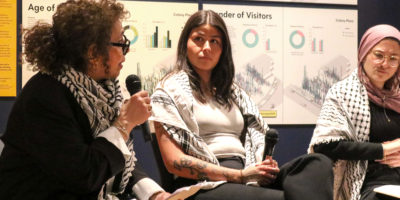By Rob Gillies
It’s 1 a.m. at Jet nightclub in Toronto. DJ Robert Hood works the crowd with his crossfading mastery, mixing hard and soulful techno beats with Master’s at Works house classic “Voices In My Mind.” The vocals are so passionate, they drip from the grooves. You can’t help but shake your ass or nod your head as Hood, a black techno DJ and producer from Detroit, works 500 white ravers into a frenzy.
Sixteen years ago in Detroit, Hood’s mentor Juan Atkins created techno’s first song, “Clear.” Yet today, America’s music industry is marketing techno or electronica as European music made by the Prodigy and The Chemical Brothers.
Electronica is now some new sound from Europe. African-Americans from Detroit invented it, Europeans embraced it, twisted it and now America’s music industry is selling it to a mainstream audience.
Developed by Juan Atkins, Derrick May and Kevin Saunderson, three black middle-class Detroit teenagers, techno was influenced by the European industrial pop sound of Kraftwerk and the funk sounds of George Clinton.
Using synthesizers, keyboards and sequencers, Atkins and his proteges Mau and Saunderson made rhythmic music that reflected their soul.
While Motown’s optimistic sound reflects Detroit in its boom years, techno reflects Detroit after the riots of the 1960s and the subsequent white flight to the suburbs. Techno became a soundtrack for the hopes and aspirations of those who remained in the decaying city.
“When we make this music we’re reflecting back on the riots and all that has gone in in Detroit over the years, and we’re expressing that pain, sorrow and strength in our music,” says Detroit DJ and producer Stacey Pullen via telephone from his studio. Pullen followed the example set by Atkins, May and Saunderson.
But when the trio first DJ’d techno at parties, black people didn’t understand it. Accustomed to funk and R&B, the crowd laughed at techno’s marriage of soul and technology. But the Godfathers of Techno, as they later became known, didn’t give up. They didn’t get much work, either.
Eventually, they opened a club not knowing if anybody would show up. Those who did loved it, and with the help of an open-minded radio DJ names Electrifyin’ Mojo, word got out about their funky electronic sounds. The Detroit Music Institute became the hottest club in Detroit and the black community embraced techno. Like Detroit’s population, the clu’s crowd was 80 per cent black and 20 per cent white.
“The Music Institute was something very special, no other club in Detroit’s history compares. There was a feeling that you were part of a tribe,” says longtime techno fan Abdu Huqq, a Detroit artist.
But when rap emerged onto the scene, techno was shunted aside and the club closed its doors. Unlike the subliminal messages of techno, many people could immediately relate to rap’s street-wise lyrics.
“That cut down our audience in the black community by 80 per cent,” say DJ and producer Carl Craig from his Detroit studio.
Atkins, May and Saunderson retreated to their synthesizers. Atkins created his own record label, Metroplex, while Saunderson founded KMS records. May created the Transmit record label and recorded the breakthrough recording “Nude Photo” with the help of Craig. The song attracted the attention of Englishman Neil Rushton, who set about trying to find major record deals for the young techno artists in England.
One British Artists & Repertoire representative suggested the three join forces and become a black version of the Pet Shop Boys. This prompted nothing but disgust from the young techno artists. Eventually Rushton formed his own record label and “Nude Photo” and other Detroit songs like it became hits in Britain’s emerging rave scene in 1987.
Europeans began to embrace techno after all-night dance parties called raves became wildly popular throughout the continent. May and Saunderson were idolized. Almost every weekend they would fly to Europe and DJ before 2,000 or more people in abandoned factories or in remote spots in the country. The parties, fueled by the sheer boredom and disillusionment of Europe’s working class youth, became a lifestyle for thousands. For many Europeans, this lifestyle paralleled that of the ‘60s hippies, as there was a sense of peace and unity and plenty of drugs were ingested.
In 1988, Saunderson teamed up with vocalist Paris Grey to form Inner City. The two took techno to a whole new commercial audience with their songs “Big Fun” and “Good Life.”
By 1992, hundreds of European record labels were producing techno. While European producer A Guy Called Gerald upheld the standard set by Detroit with his song “Voodoo Ray,” many European producers make a mockery of the music. Much of the soul the Detroit originators reflected in the music was lost.
“Most European producers approach this music on a more technical plane than we do,” say Detroit DJ and producer Kenny Larkin. “They place too much emphasis on the computers and it comes out sounding dull and lifeless.”
With so much bad techno being produced, many underground dance music enthusiasts now refuse to listen to it. Their perception of techno music is comparable to someone who thinks all hip hop music sounds like “Ice Ice Baby.” So they think all hip hop shit and they miss out on hearing A Tribe Called Quest.
Techno originator Derrick May is saddened that the perception black people have of techno is based on all the bad techno that’s been produced.
“It’s sad because black people don’t want to know about techno and I can respect why they don’t because the music they’ve heard doesn’t have any soul,” says May over the phone from his Transmit studio in Detroit.
May laughs at America’s music industry for marketing the music of European producers, who he says have misappropriated the Detroit sound.
“Techno was turned into and easy-money music for people with T-shirts and really super big jeans,” says May. “Suburban kids are buying keyboards and calling themselves artists, and record companies are endorsing this, which is hilarious.”
While May is not signed to a major record company, he is by no means a struggling musician. As one of the best underground DJs in the world, May often receives five-figure fees for two-hour DJ sets. He jets around the world and stays at posh hotels. Not a bad life.
But while May rakes in the dough, other Detroit musicians are bothered by the lack of respect major American labels have shown them.
DJ and producer Alan Oldham thinks racism is one of the reasons America’s music industry markets European groups instead of Detroit artists.
“They’ll market gangster rap because that’s what’s expected of black people,” says Oldham. “But they won’t market intelligent artistic music because that’s not what’s expected of us.”
Now that America’s music industry has created and packaged electronica’s image with bands like the Chemical Brothers and Prodigy, electronica fans are not likely to hear what the roots of techno sound like.
“They’ve made it so commercial that it doesn’t sound like techno anymore,” explains Detroit DJ and producer Carl Craig, who is widely considered techno’s top producer today. “It’s kind of like saying Kenny G is jazz. If you listen to a Duke Ellington record or you listen to a Miles Davis record then you know that Kenny G is nowhere close to jazz, it’s just pop.”
But since Americans only began to appreciate jazz once it was recognized by the Europeans, techno originator Juan Atkins hopes history will repeat itself. For now, he’s remaining patient.
“You can’t bring the wall of ignorance all down at once,” he says. “I just keep chipping away at it.”










Leave a Reply